| Vintage Pulp | Dec 25 2022 |

This Cameron Kay fella might just amount to something one day.
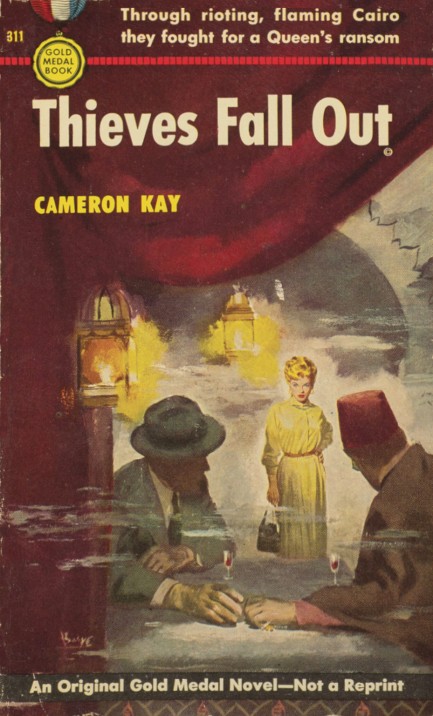
Cameron Kay was a pseudonym used by literary leading light Gore Vidal when he was short of cash and needed to publish and get paid fast. He'd used other pseudonyms for this purpose, including Edgar Box and Katherine Everard. It took him about three weeks to produce 1953's Thieves Fall Out, and he made three grand on the deal. It's one of those books where a money-seeking rando goes to a foreign country and immediately inserts himself into the biggest caper going for hundreds of miles around—and does it, improbably, with great ease, while seeming to think, irrationally, that it's a good idea. This character, named Peter Wells, ultimately turns sour on the venture and must figure out a way to flee Egypt with his true love by his side.
Though Vidal is not at the heights he'd reach in his best writing, you already know that going in. In the final analysis he gets the job done, like a good carpenter working on a quick side project. We glanced at a few reviews after finishing the story and they seem to miss the point that Vidal does exactly what adventure fiction requires. Saying the book's plot is stock is like saying dance music is repetitive. It has to be that way to make you dance. Because of the identity of the author, it feels as if reviewers try to flaunt their intellectual bona fides by trashing the result. We're not going to do that. The book is satisfactory.
What Vidal does especially well is local color—though refracted through a wealthy Western prism that few Egyptians would appreciate. Yet it's clear he tries to be egalitarian, if imperfectly, and he crafts a tale with unique characters. There's a piano playing hunchback who hides behind a wall and looks at his nightclub through a peephole, a beautiful French countess who was once the mistress of Egypt's top Nazi, and a fresh young beauty who's the unrequited love of King Farouk of Egypt—who has her followed everywhere by his secret police. Those ideas are unusual, for sure, but they're not as farfetched as some reviewers would like you to think.
We make that statement confidently because we've lived in the wilder world. In Guatemala we met an ex-judge from a proximate country who had fled because of being targeted for death by the new ruling party, but who was a drunk who craved public enjoyment and had shaved his head and grown a beard in order to hang in dive bars unrecognized. Was his story true? Maybe. He had a judicial identification card he eventually showed us that looked real enough. Real enough, in fact, that we gave him a wide berth from then on, thinking that if he was assassinated we didn't want to be in the line of fire. It may not sound real, but there you go. It happened.
Therefore we don't agree with reviewers who think Vidal's characters are intentionally absurd, and that he was pushing the envelope of how bizarre he could make his cast. Such people exist. Vidal would have found them. They make Thieves Fall Out a fascinating read. The book isn't top of the genre, nor bottom, but it's unique, and has a fun climax tied into the burgeoning Egyptian revolution and the real-life fire that destroyed one of the most famous hotels in the world. Here's what Thieves Fall Out is in summation: readable, distracting, and just leftfield enough to let you know the author is someone with a different take on the world, who'd later distill his ideas into fiction that would make him a literary sensation.
Therefore we don't agree with reviewers who think Vidal's characters are intentionally absurd, and that he was pushing the envelope of how bizarre he could make his cast. Such people exist. Vidal would have found them. They make Thieves Fall Out a fascinating read. The book isn't top of the genre, nor bottom, but it's unique, and has a fun climax tied into the burgeoning Egyptian revolution and the real-life fire that destroyed one of the most famous hotels in the world. Here's what Thieves Fall Out is in summation: readable, distracting, and just leftfield enough to let you know the author is someone with a different take on the world, who'd later distill his ideas into fiction that would make him a literary sensation.
| Intl. Notebook | Feb 21 2022 |

Swiss bank receives long deserved exposure thanks to data leak.

We're occasionally asked why we don't do modern true crime write-ups as often as we once did. There are a couple of reasons. We actually have jobs, and the research on crime stories is time consuming. But secondly, modern day swindles, scams, and corruption are out of control to the extent that writing about them seems redundant. But we're making an exception today because one of our previous subjects, who we wrote about way back in 2009, has popped up in the news again. That would be Hisham Talaat Moustafa, who was sentenced to death for hiring out the murder of his ex-girlfriend, Lebanese pop star Suzanne Tamim. His was one of thousands of names just revealed in a massive financial data leak from Credit Suisse, one of the most prestigious banks in Switzerland, which hides money for the richest people in the world.
We think everyone knows Swiss banks are corrupt, right? Their first secrecy laws were adopted in 1713. It's safe to say they've been corrupt for almost that long. Over the years Credit Suisse's clients have included Ferdinand and Imelda Marcos, who stole $10 billion from the Philippine treasury, Romanian dictator Nicolae Ceausescu, Panamanian drug lord and CIA informant Manuel Noriega, thousands of Nazis who were hiding their expropriations, and countless shady shell companies. One can insert the usual objections about taxes here, but the point is that regular people must pay them, yet the rich and powerful somehow always manage to avoid their fair share, even when they've generated their loot through illegal or even genocidal means. As with many morally rudderless institutions and people, what Swiss banks do is perfectly legal, but “perfectly legal” is the phrase uttered by people who know they're willfully engaged in behavior that obviously should be illegal—and in fact is illegal for everyone but the rich and connected.
people must pay them, yet the rich and powerful somehow always manage to avoid their fair share, even when they've generated their loot through illegal or even genocidal means. As with many morally rudderless institutions and people, what Swiss banks do is perfectly legal, but “perfectly legal” is the phrase uttered by people who know they're willfully engaged in behavior that obviously should be illegal—and in fact is illegal for everyone but the rich and connected.
 people must pay them, yet the rich and powerful somehow always manage to avoid their fair share, even when they've generated their loot through illegal or even genocidal means. As with many morally rudderless institutions and people, what Swiss banks do is perfectly legal, but “perfectly legal” is the phrase uttered by people who know they're willfully engaged in behavior that obviously should be illegal—and in fact is illegal for everyone but the rich and connected.
people must pay them, yet the rich and powerful somehow always manage to avoid their fair share, even when they've generated their loot through illegal or even genocidal means. As with many morally rudderless institutions and people, what Swiss banks do is perfectly legal, but “perfectly legal” is the phrase uttered by people who know they're willfully engaged in behavior that obviously should be illegal—and in fact is illegal for everyone but the rich and connected.Credit Suisse is trying to pretend that the leak reveals old accounts from before the bank cleaned up its practices (which it never substantially did), but the spin won't be effective because the data reveals that the bank is currently holding money for human traffickers, drug lords, oligarchs, stock cheats, treasury looters, mafia kingpins and—in the case of Hisham Moustafa—murderers. Correction—pardoned murderers, since he was released thanks to presidential decree in 2017. The information on all this corruption was originally passed to the German newspaper Süddeutsche Zeitung via an anonymous whistleblower, and the odds are good that in a matter of weeks or months that currently unknown person will be outed and have to make a full time job of trying to avoid the total destruction of his or her life and a prison sentence—no pardon pending.
Tax and corruption problems have exploded globally as elite greed has grown, the profits from criminality have soared, digital technology has created previously-unheard-of fortunes, offshoring of profits has become standard practice, deregulation and the de-facto dissolving of anti-trust laws have allowed corporations to grow more powerful than countries, and austerity has shrunk or eliminated the enforcement mechanisms of public institutions. In fact, in addition to funneling money from regular people to corporations and the rich, the other point of austerity is to shrink government to prevent it prying into the affairs of corporations and the rich. Libertarians rejoice. Insider trading, commodities fraud, and money laundering are all now rampant, and there's nothing people can do about it because the government institutions meant to be centers of oversight were taken over by the rich decades ago.
Moustafa paid to have his girlfriend knifed to death. Unlike murderers able to hide behind the fig leaf of non-conviction, his guilt was established as a fact during a criminal court proceeding. He was sentenced to hanging but was retried and had his punishment reduced to a mere fifteen years. He spent, in total before his pardon, nine years in a country club prison, and all the while managed his wealth, built up his billions, and came out of jail not disgraced and shunned, but welcomed, feted, and once again demanding and receiving VIP treatment, the best tables in the best restaurants, and the ear of the global elite. He threw a few coins to charity along the way to spit-shine his reputation, had his thriving conglomerate Talaat Moustafa Group donate some COVID vaccines, but still he's a murderer who wriggled loose from the hangman's noose, and today enjoys every privilege he ever enjoyed—while his victim is dead forever.
came out of jail not disgraced and shunned, but welcomed, feted, and once again demanding and receiving VIP treatment, the best tables in the best restaurants, and the ear of the global elite. He threw a few coins to charity along the way to spit-shine his reputation, had his thriving conglomerate Talaat Moustafa Group donate some COVID vaccines, but still he's a murderer who wriggled loose from the hangman's noose, and today enjoys every privilege he ever enjoyed—while his victim is dead forever.
 came out of jail not disgraced and shunned, but welcomed, feted, and once again demanding and receiving VIP treatment, the best tables in the best restaurants, and the ear of the global elite. He threw a few coins to charity along the way to spit-shine his reputation, had his thriving conglomerate Talaat Moustafa Group donate some COVID vaccines, but still he's a murderer who wriggled loose from the hangman's noose, and today enjoys every privilege he ever enjoyed—while his victim is dead forever.
came out of jail not disgraced and shunned, but welcomed, feted, and once again demanding and receiving VIP treatment, the best tables in the best restaurants, and the ear of the global elite. He threw a few coins to charity along the way to spit-shine his reputation, had his thriving conglomerate Talaat Moustafa Group donate some COVID vaccines, but still he's a murderer who wriggled loose from the hangman's noose, and today enjoys every privilege he ever enjoyed—while his victim is dead forever.This is the place in which we find ourselves. We all understand, if we actually absorb factual information rather than apologist propaganda or fanciful myth, that the rich have fucked up this world, and the rest of us, as well as future generations, are going to pay to clean up the mess. If it can even be cleaned up, which is doubtful. And that's why we stopped writing about modern crime and corruption. It's pointless. It's banal. Writing about old crimes is an escape, a window into history and the mad hearts of men and women who are long, long gone. Writing about current crimes is self-flagellation. We'll still do it on occasion when the urge strikes, like today, but we're well aware that people tend to complain more as time goes by and we don't want to fall into that trap. We want Pulp Intl. to be a place of entertainment and wonder—by which we mean amazing art, exciting fiction, bizarre historical and Hollywood facts, and beautiful women.
| Vintage Pulp | Jul 19 2021 |

Can't stop the spread, can't hope to contain it.

The colorful cover of this book attracted us, but the unusual title struck us too. Alien Virus? How could we resist that? The teaser tells us Alan Caillou's novel is a thriller set in exotic Cairo, so we were pretty sure the title was figurative and there'd be no viruses or aliens. We also learned from the rear cover that this is an espionage tale. When we cracked it open it became clear that, indeed, there is no literal virus. So then to what does the title refer? The book is set in Cairo before Gamal Abdel Nasser came to power in 1956, but sometime after the 1952 uprising that many historians consider a marker for the end of British rule there. Here's the passage that explains the title:
This was the way they would march, down from the big square to the wide streets and the midans, chanting their slogans, carrying their leaders on their shoulders, holding aloft their placards, and the [instigators] would watch and know just when to set the fires, and there would be shots in the dark alleyways, and a man would be kicked to death and the crowds would gather to watch the fun and then take part in the burning and the looting and the destruction and the killing, and bombs would be be thrown and men would be bleeding in the streets after they had passed. There was an alien virus at work.
Yep, Alien Virus is another glorification of empire, which posits that Brits deserved to steal and rule others' lands, with the violence used to do so neatly excised from the annals of western history, replaced by a myth describing colonials as pragmatic and occasionally firm rulers, but generally benevolent, and who of course transformed distant cultures in beneficial ways, and even left behind cricket and polo, invaluable gifts. But history—when those who've been subjugated and occupied are given a chance to speak—is not so clean or pretty as western books would have you believe, and plunderers cannot be heroes or saints.
Despite the point-of-view being colonial, Alien Virus is an entertaining tale. It was originally published in 1957, with this Panther Books edition coming in 1961, and was written by a man who knew Egypt well, understood the workings of both the western diplomatic service and the Cairo underground, and spoke the local languages. So confident is Caillou in his storytelling that he doesn't even bother to translate the numerous snippets of French and Arabic speech, preferring to impart meaning by mood, a high-minded literary choice unusual for the period as far as we know, and which even today is attempted only by the most self assured authors writing for the most understanding publishers.
There are several major characters in Alien Virus, but in the center of the action is Julius Tort, who catches wind of a serious destabilization plot, but at first can't figure out the where, when, and who of it all. Could it be Russians? Could it be a local religious faction? He may not know, but the reader certainly does, as Caillou gives glimpses into terrorist cells. He doesn't use that terminology, though, and the cells aren't very formal. They're just ragtag cabals, but armed and determined to see Brits out of their country. We won't reveal more. Instead we'll end with a fun dialogue exchange between the protagonists. It happens after a stabbing. The victim, Bolec, in addition to fresh knife wounds, has been suffering from hemorrhoids:
“A good job you have an appetite, my friend. Those spare tyres have saved your life. We'll have to put you in the hospital for a few hours.”
Perugino said maliciously: “Don't forget to have the doctor cut out your piles, Bolec. He might cut out your coglione at the same time.”
“All right, you wait, you get this thing, you not laugh about it.”
“Is strange, is it not?” Perugino mused, “Let us agree that the backside is the only intrinsically humorous object which is shared by both the nobility and the bourgeoisie. Bourgeoisie behinds have a different popular name, is it not so? But all the same, whatever you call them...”
Tort said: “A rose by any other name.”
“Whatever you call it, it is subject to same indignities and the same discomforts.”
“This is my backside you talking about!” Bolec shouted.
“If I were a wealthy man,” Perugino went on, “it would cause me a great deal of unhappiness to know that from at least one aspect I was no better than the common beggar. But as it is, I can find a certain comfort in it.”
| Vintage Pulp | Jan 8 2021 |

The Devil went down to Southeast Asia looking for fortunes to steal.
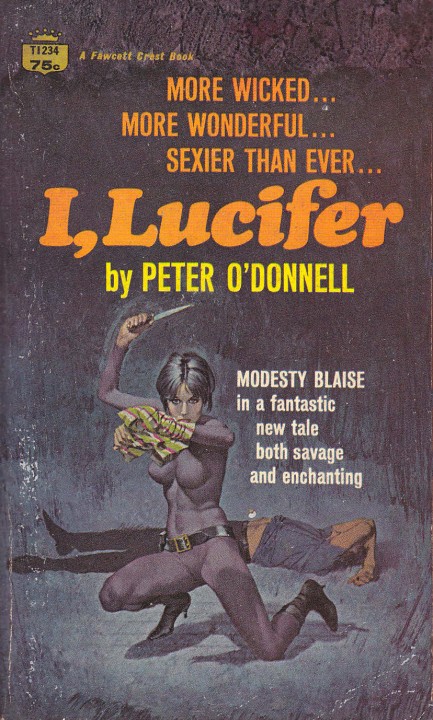
1969's I, Lucifer is Peter O'Donnell's third Modesty Blaise novel, and it's a series we're going through mainly to highlight the great cover art by Robert McGinnis. He didn't illustrate all the books. In fact, this might be the last, which means we'll probably move on to other authors. But that won't be because the Blaise books aren't good. In fact, for the sexy spy genre they're top notch—exotically located, compellingly plotted, and peopled by wacky Bond-style supervillains. Case in point: the titular character in I, Lucifer is a man suffering from a psychotic delusion that he's Satan. The funny part is he isn't evil. The real evil guy is Seff, the opportunist who launches a global extortion scheme that hinges on faux-Lucifer's participation even though his delusion prevents him having a clue what he's really doing. Lucifer might be the only villain we've encountered in a novel who's a victim.
When Seff's murderous extortion hits too close to home for Modesty, she and sidekick Willie Garvin gear up and eventually end up in the Philippines, where they right some wrongs, explosively. As usual Modesty uses sex to get over on the bad guys, and it's a major part of what readers enjoyed about the series. At one point she ponders whether a colleague thinks she's promiscuous. Well, no, she isn't by 1969 standards. But the joy of literature is she can be unpromiscuous, yet we can be there in the room for every one of her widely spaced encounters. This book is particularly amusing along those lines, as it brings two of Modesty's lovers together to be uncomfortable and/or jealous as they're displaced by a third. But sleaze fans will need to look elsewhere. O'Donnell is subtle—if not poetic—with his sex scenes.
Though the sexual aspects of Modesty Blaise were a major attraction of the novels, we enjoy even more the tactical nature of O'Donnell's action, which is probably an influence from his military service in Iran, Syria, Egypt, Greece and other places. It's also probably why so much of the Blaise series is connected to that region. While the tales are always exotic, this entry is even wilder than usual. How wild? It involves precognition, trained dolphins, Moro mercenaries, and body implants that kill remotely, yet it all works. That's because as always, in the center of the chaos, you have Blaise and Garvin, perfect friends, platonic soulmates, and two armed and extremely deadly halves of a razor sharp fighting machine. Abandon all hope ye who cross them.
| Vintage Pulp | Sep 23 2020 |

Recent excavation reveals rare and wonderful treasures.


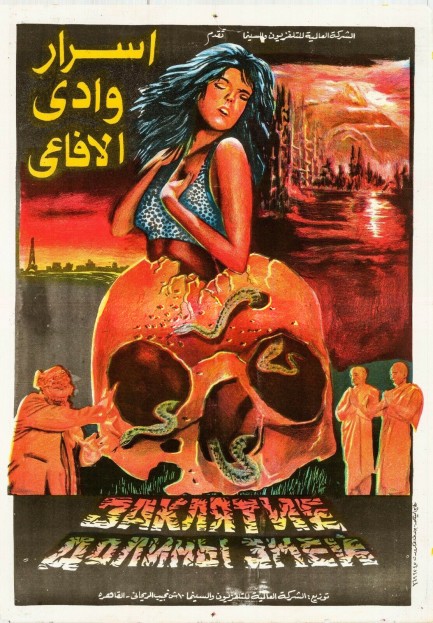

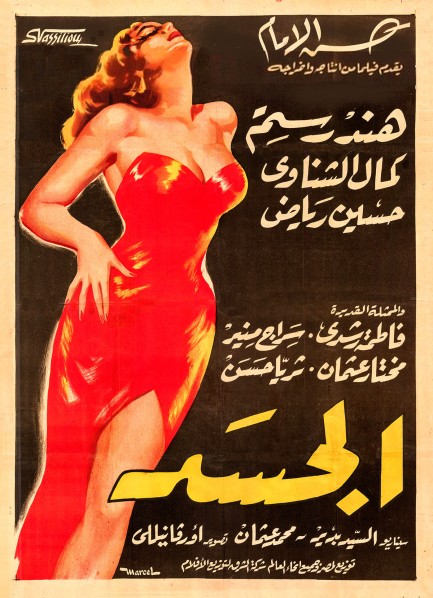



Egypt is a land of ancient artifacts, but it isn't one of pulp or pulp influenced art. Even so, we did some deep digging and found a few items that may fit the bill. These movie posters were painted by artists such as Ahmed Hamed, Hassan Mazhar Gasour, and the tandem of Stamatis Vassiliou & Marcel during the ’50s, ’60s, and ’80s. You see here, top to bottom, Fattouma, 1961, Thawrat el-Madinah, aka A Town's Revolt, 1955, Klatwa doliny wezy, aka Curse of Snakes Valley, 1988, two posters for El gessad, aka Flesh, 1955, two posters for Fi baitina rajul, aka There Is a Man in Our House, 1961, starring Omar Sharif, and finally, Iterafat zauja, aka A Wife's Confession, 1954. These may not be executed as the highest level, but they're quirky and colorful, which is good enough for us. We'd take any of these in a frame and be happy. See another Egyptian poster with Pam Grier—or a reasonable likeness of her—at this link.
| Vintage Pulp | May 19 2020 |

Sheba Shayne takes aim at Egypt.

Above is an Egyptian promo poster made for Pam Grier's blaxploitation flick Sheba, Baby, in which she played the title character Sheba Shayne (surely one of the best names for a PI ever). We have no Egyptian premier date for the film, but it probably happened well after its 1975 U.S. opening, maybe even as late as ’77 or ’78. Does the figure on the poster look like Grier? Not as much as it could, but we think it's a fun piece of art anyway.
| Vintage Pulp | Sep 20 2019 |

Plundering priceless cultural treasures can be loads of fun.
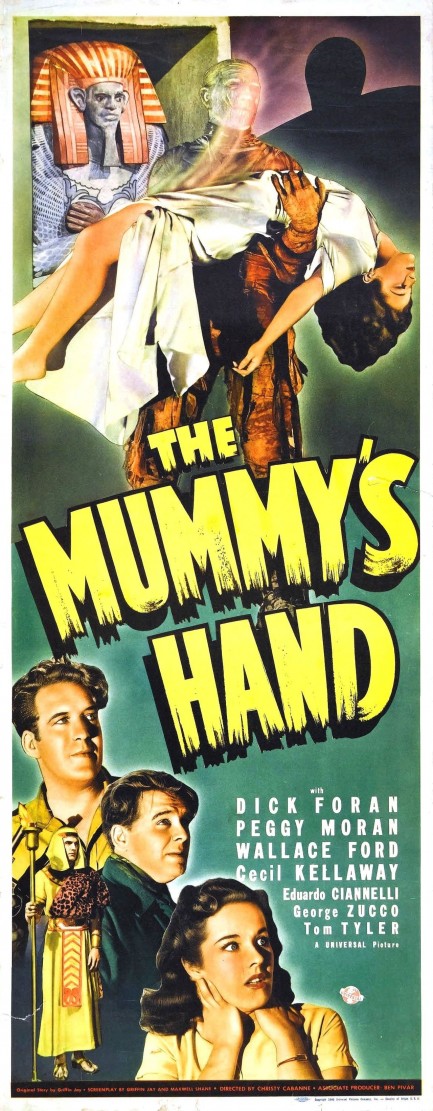
We haven't seen many mummy movies but if they're all like this one we'll look for more. The Mummy's Hand is a deft blend of comedy and thrills, with Dick Foran and Wallace Ford playing a pair of goofy archaeologists in Egypt who stumble upon clues that point to the jewel laden tomb of a dynastic princess. They don't have any cash, so they charm Cecil Kellaway, who here is credited as Cecil Kelloway, into financing the expedition. His daughter, the beautiful Peggy Moran, comes along for the ride.
Everyone is good in this, but Kelloway is especially enjoyable. He plays a famous magician, very adept but a bit distracted, which leads to several amusing moments, including one in which he gets locked in his own steamer trunk. There isn't a single Egyptian in this film, just white guys wearing brown shoe polish and scraggly beards, but casual cultural insensitivity is par for the course during this era. Depending on what you're willing to overlook The Mummy's Hand is about as good-natured and fun as a film gets. It premiered in the U.S. today in 1940.

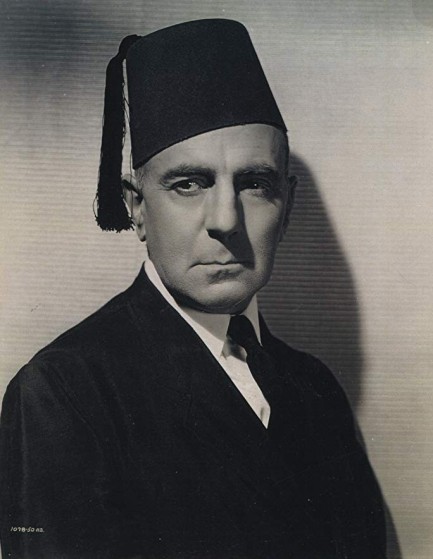
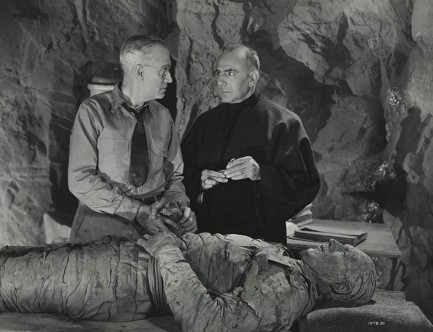



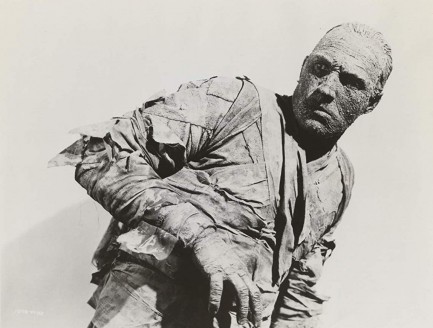
| Vintage Pulp | May 2 2019 |

Lady, if you don't stop blocking my view I'm going to strangle you and leave you buried with the pharaohs.
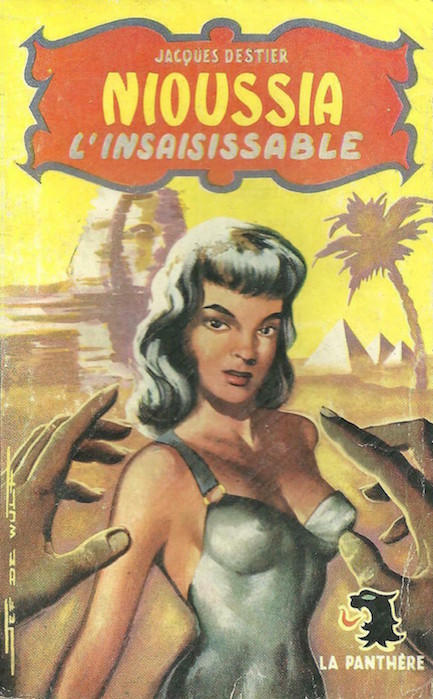
We never go long without sharing art from French illustrator Jef de Wulf, and here he is again doing cover work for publisher Éditions de la Flamme d'Or and author Jacques Destier, whose Egyptian adventure Nioussia l'insaisissable was published in 1954. Destier was a pseudonym used by Jacques Thinus. If your French is rusty, Nioussia, l'insaisissable means “Nioussia, the elusive.” See de Wulf at his best here and here, and we'll have more from him a bit later.
| Vintage Pulp | Aug 6 2018 |

Gemser heats up the deserts of Egypt.

Cinematic sleaze was often fueled, the same as was mainstream filmmaking, by star power, so it was natural to bring two popular erotic performers like Laura Gemser and Annie Belle together. It happened today in 1976 with the Italian premiere of Velluto nero. At some point after its theatrical release it was renamed for English speaking audiences Black Emmanuelle, White Emmanuelle. Gemser was actually Indonesian, born in Surabaya, East Java, however 1976 was the blaxploitation era and everybody wanted a piece of that pie, including, obviously, Gemser's production company Rekord Films. Gemser could have played anything from half black to Persian to southern Italian to Hawaiian to Latina, so it was a canny—if cynical—bit of cultural appropriation. But back then it was seemingly no harm no foul. Audiences wanted to see her naked, and she always delivered.
In Velluto nero Gemser plays a model who vacations in Egypt with her horrible husband and meets the free-spirited Belle, who awakens her to better possibilities in life—ones that don't include her criminally abusive spouse. It's generally agreed that this is one of Gemser's most tepid Emanuelle entries. We have to concur. But Gemser and Annie Belle in the same movie are worth something, at least, and the Egyptian scenery is compelling. We also like that Belle's multi-colored sweater makes another appearance. She must have lifted it from the costume department when she filmed Laure. Velluto nero isn't the last we'll see of her or Gemser, and we'll just have to hope the next encounter is an improvement over this one.
In Velluto nero Gemser plays a model who vacations in Egypt with her horrible husband and meets the free-spirited Belle, who awakens her to better possibilities in life—ones that don't include her criminally abusive spouse. It's generally agreed that this is one of Gemser's most tepid Emanuelle entries. We have to concur. But Gemser and Annie Belle in the same movie are worth something, at least, and the Egyptian scenery is compelling. We also like that Belle's multi-colored sweater makes another appearance. She must have lifted it from the costume department when she filmed Laure. Velluto nero isn't the last we'll see of her or Gemser, and we'll just have to hope the next encounter is an improvement over this one.
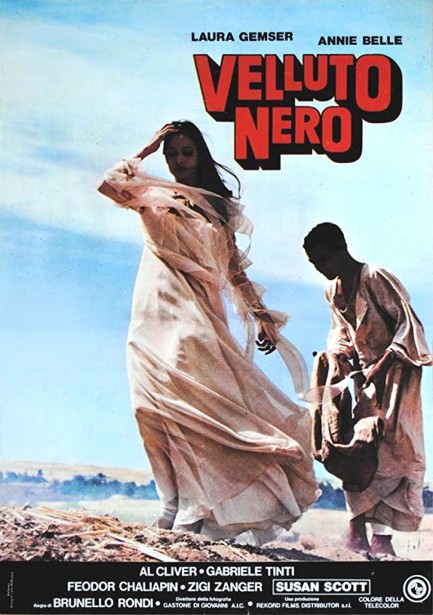



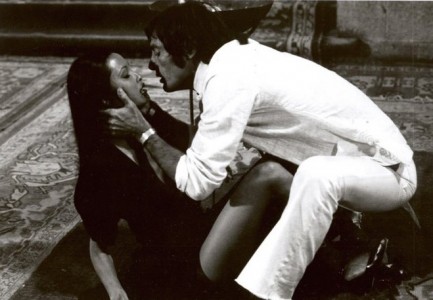








| Modern Pulp | Feb 11 2017 |

The riddle is this: why didn't Lesley-Anne Down wear that outfit?


We'll admit we watched Lesley-Anne Down's 1981 thriller Sphinx just to see if she ever got into the gauzy number she's wearing in the promo photo above. We thought it unlikely, and we were right. She mostly wore what you see below—no spike heels with asp straps, sorry. But it wasn't the worst expenditure of time, finding this out. Sphinx feels like a television movie by today's standards, but the location shooting is excellent, and some interesting performers pop up—among them Sir John Gielgud and John Rhys-Davies, the latter of whom you may remember as Sallah from another Egyptian themed movie—Raiders of the Lost Ark, which hit cinemas four months after Sphinx. Like Raiders, in Sphinx you get an antiquarian on the trail of a lost tomb while baffled by arcane clues and beset by duplicitous locals. We don't think a single Egyptian had a noteworthy role here, but at least a few of the cultural details are accurate (though perhaps not the most flattering ones). Are we recommending this one? Not without Down wearing that outfit we aren't, but the movie isn't as bad as many would have you believe. It premiered today in 1981, and the awesome poster was painted by Bob Peak.







































































